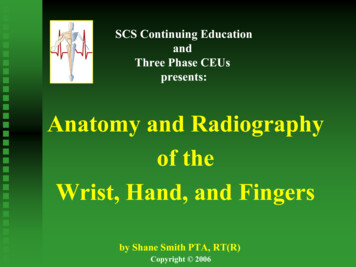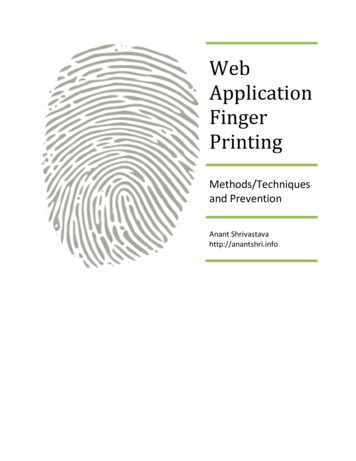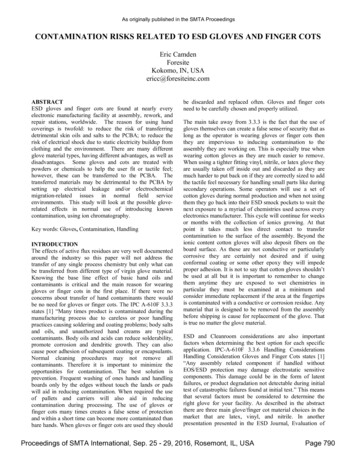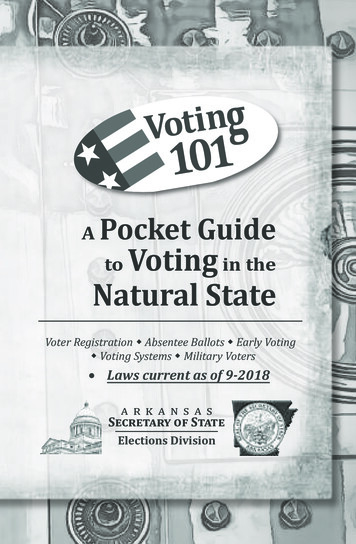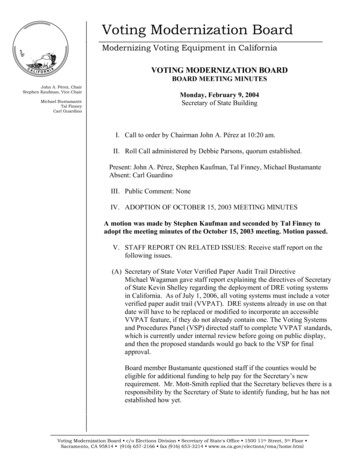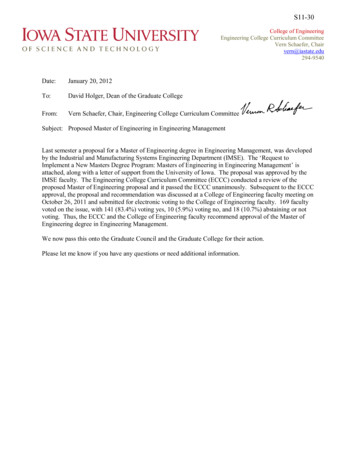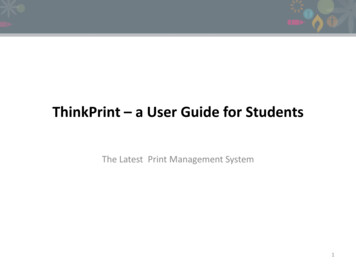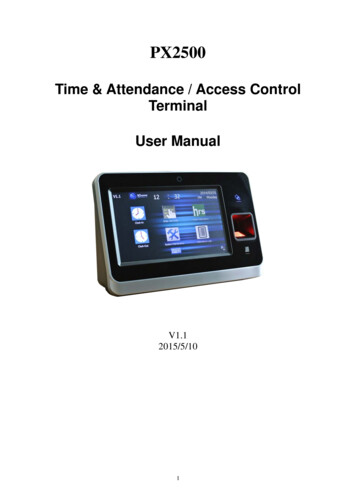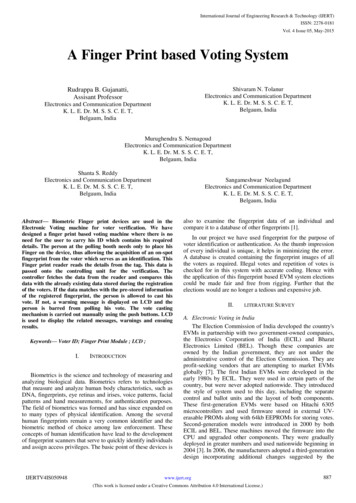
Transcription
International Journal of Engineering Research & Technology (IJERT)ISSN: 2278-0181Vol. 4 Issue 05, May-2015A Finger Print based Voting SystemShivaram N. TolanurElectronics and Communication DepartmentK. L. E. Dr. M. S. S. C. E. T,Belgaum, IndiaRudrappa B. Gujanatti,Assisant ProfessorElectronics and Communication DepartmentK. L. E. Dr. M. S. S. C. E. T,Belgaum, IndiaMurughendra S. NemagoudElectronics and Communication DepartmentK. L. E. Dr. M. S. S. C. E. T,Belgaum, IndiaShanta S. ReddyElectronics and Communication DepartmentK. L. E. Dr. M. S. S. C. E. T,Belgaum, IndiaSangameshwar NeelagundElectronics and Communication DepartmentK. L. E. Dr. M. S. S. C. E. T,Belgaum, IndiaAbstract— Biometric Finger print devices are used in theElectronic Voting machine for voter verification. We havedesigned a finger print based voting machine where there is noneed for the user to carry his ID which contains his requireddetails. The person at the polling booth needs only to place hisFinger on the device, thus allowing the acquisition of an on-spotfingerprint from the voter which serves as an identification. ThisFinger print reader reads the details from the tag. This data ispassed onto the controlling unit for the verification. Thecontroller fetches the data from the reader and compares thisdata with the already existing data stored during the registrationof the voters. If the data matches with the pre-stored informationof the registered fingerprint, the person is allowed to cast hisvote. If not, a warning message is displayed on LCD and theperson is barred from polling his vote. The vote castingmechanism is carried out manually using the push buttons. LCDis used to display the related messages, warnings and ensuingresults.Keywords— Voter ID; Finger Print Module ; LCD ;I.INTRODUCTIONBiometrics is the science and technology of measuring andanalyzing biological data. Biometrics refers to technologiesthat measure and analyze human body characteristics, such asDNA, fingerprints, eye retinas and irises, voice patterns, facialpatterns and hand measurements, for authentication purposes.The field of biometrics was formed and has since expanded onto many types of physical identification. Among the severalhuman fingerprints remain a very common identifier and thebiometric method of choice among law enforcement. Theseconcepts of human identification have lead to the developmentof fingerprint scanners that serve to quickly identify individualsand assign access privileges. The basic point of these devices isIJERTV4IS050948also to examine the fingerprint data of an individual andcompare it to a database of other fingerprints [1].In our project we have used fingerprint for the purpose ofvoter identification or authentication. As the thumb impressionof every individual is unique, it helps in minimizing the error.A database is created containing the fingerprint images of allthe voters as required. Illegal votes and repetition of votes ischecked for in this system with accurate coding. Hence withthe application of this fingerprint based EVM system electionscould be made fair and free from rigging. Further that theelections would are no longer a tedious and expensive job.II.LITERATURE SURVEYA. Electronic Voting in IndiaThe Election Commission of India developed the country'sEVMs in partnership with two government-owned companies,the Electronics Corporation of India (ECIL) and BharatElectronics Limited (BEL). Though these companies areowned by the Indian government, they are not under theadministrative control of the Election Commission. They areprofit-seeking vendors that are attempting to market EVMsglobally [7]. The first Indian EVMs were developed in theearly 1980s by ECIL. They were used in certain parts of thecountry, but were never adopted nationwide. They introducedthe style of system used to this day, including the separatecontrol and ballot units and the layout of both components.These first-generation EVMs were based on Hitachi 6305microcontrollers and used firmware stored in external UVerasable PROMs along with 64kb EEPROMs for storing votes.Second-generation models were introduced in 2000 by bothECIL and BEL. These machines moved the firmware into theCPU and upgraded other components. They were graduallydeployed in greater numbers and used nationwide beginning in2004 [3]. In 2006, the manufacturers adopted a third-generationdesign incorporating additional changes suggested by thewww.ijert.org(This work is licensed under a Creative Commons Attribution 4.0 International License.)887
International Journal of Engineering Research & Technology (IJERT)ISSN: 2278-0181Vol. 4 Issue 05, May-2015Election Commission. According to Election Commissionstatistics, there were 1,378,352 EVMs in use in July 2009. Ofthese, 448,000 were third-generation machines manufacturedfrom 2006 to 2009, with 253,400 from BEL and 194,600 fromECIL. The remaining 930,352 were the second-generationmodels manufactured from 2000 to 2005, with 440,146 fromBEL and 490,206 from ECIL [4]. (The first generationmachines are deemed too risky to use in national electionsbecause their 15-year service life has expired [5], though theyare apparently still used in certain state and local contests.) Inthe 2009 parliamentary election, there were 417,156,494 votescast, for an average of 302 votes per machine [6].this intelligent task, ARM controller is loaded with anintelligent program written in embedded „C‟ language.B. Evaluation of Voting EquipmentIn the recent years, voting equipment which were widelyadopted may be divided into five types [7].1) Paper-based voting: The voter gets a blank ballot anduse a pen or a marker to indicate he want to vote for whichcandidate. Hand counted ballots is a time and labor consumingprocess, but it is easy to manufacture paper ballots and theballots can be retained for verifying, this type is still the mostcommon way to vote.2) Lever voting machine: Lever machine is peculiarequipment, and each lever is assigned for a correspondingcandidate. The voter pulls the lever to poll for his favoritecandidate. This kind of voting machine can count up theballots automatically. Because its interface is not user-friendlyenough, giving some training to voters is necessary.3) Direct recording electronic voting machine: Thistype, which is abbreviated to DRE, integrates with keyboard,touchscreen, or buttons for the voter press to poll. Some ofthem lay in voting records and counting the votes is veryquickly. But the other DRE without keep voting records aredoubted about its accuracy.4) Punch card: The voter uses metallic hole-punch topunch a hole on the blank ballot. It can count votesautomatically, but if the voter‟s perforation is incomplete, theresult is probably determined wrongfully.5) Optical voting machine: After each voter fills a circlecorrespond to their favorite candidate on the blank ballot, thismachine selects the darkest mark on each ballot for the votethen computes the total result. This kind of machine counts upballots rapidly. However, if the voter fills over the circle, itwill lead to the error result of optical scan.III.BLOCK DIAGRAMThe system aims at developing a fingerprint basedadvanced Electronic Voting Machine (EVM) which helps infree and fair way of conducting elections which are basis fordemocratic country like India .This project consists offollowing units a Voting system, fingerprint module and ARMcontroller Unit. The voter first puts his finger on the fingerprintmodule which checks for the authentication of the user. If thevoter is the authenticated one, he will now poll his vote in thevoting system by simply pressing button against his favoriteleader through a button. The control unit consists of a ARMcontroller, push button for different operations of EVM. Thevotes casted for particular candidate in that particular section ofconstituency is shown through an LCD display. To performIJERTV4IS050948Fig. 1. Block diagram of biometric voting systemA. ARM ControllerARM controller is Brain of this project, it has the featureslike 32-bit ARM7TDMI-S microcontroller in a tiny LQFP64package.8 kB to 40 kB of on-chip static RAM and 32 kB to512kB of on-chip flash memory. 128-bit wideinterface/accelerator enables high-speed 60 MHz operation.Various 32-bit timers, single or dual 10-bit ADC(s), 10-bitDAC, PWM channels and 45 fast GPIO lines with up to nineedge or level sensitive external interrupt pins make thesemicrocontrollers suitable for industrial control and medicalsystems.B. Fingerprint moduleThe device is the most popular among all the identificationdevices because of its ease in acquisition, and also the numberof sources that are available for its data collection. It has foundits vast use in law enforcement and immigration purposes .Themodule used here is R305. The basics of this identificationprocess comes from “Galton points” – a certain characteristicsdefined by Sir Francis Galton, through which the fingerprintscan be identified. In this module the scanned image arecompared with an earlier existing finger print of yours to getthe correct identity. The comparison is carried out by theprocessor and the comparison is made between the valleys andridges though your whole fingerprint is recorded, the computertakes only parts of the print to compare with other recordsC. MAX-232The MAX-232 is an integrated circuit that converts signalsfrom an RS-232 serial port to signals suitable for use in TTLcompatible digital logic circuits. The MAX-232 is a dualdriver/receiver and typically converts the RX, TX, CTS andRTS signals .The drivers provide RS-232 voltage level outputs(approx. 7.5 V) from a single 5 V supply via on-chipcharge pumps and external capacitors.D. Crystal oscillatorAn electronic oscillator is an electronic circuit thatproduces a repetitive Electronic signal, often a sine wave or asquare wave. ARM controller internally having 4 Mhz clockfrequency. We are giving the 60 Mhz clock frequency as anexternal source for increasing the system performance.www.ijert.org(This work is licensed under a Creative Commons Attribution 4.0 International License.)888
International Journal of Engineering Research & Technology (IJERT)ISSN: 2278-0181Vol. 4 Issue 05, May-2015E. Power source moduleThe major blocks of power supply are given belowTransformer, Rectifier, Filter, 7805 voltage regulator .Thesewill provide the regulated power supply to the unit which isfirst converted into 12V AC .12V AC is converted into DCusing rectifier circuit .Finally the 7805 voltage regulatorprovides constant 5V DC supply which will be given to circuit.IV.WORKINGA. Flow ChartThis process basically consist of two stages1.Voter enrollmentF. KeypadPush buttons are used in keypad. A push-button or simplybutton is a simple switch mechanism for controlling someaspect of a machine or a process. Buttons are typically madeout of hard material, usually plastic or metal.G. ResetThis button is used to reset the whole system so that it canbe configured for next election.Fig. 2. Voter enrollmentIJERTV4IS050948www.ijert.org(This work is licensed under a Creative Commons Attribution 4.0 International License.)889
International Journal of Engineering Research & Technology (IJERT)ISSN: 2278-0181Vol. 4 Issue 05, May-20152.Vote castingV.RESULTA. Enrollment1) Voter enrollmentFig. 4. Enrolling of the user2) Search of registered voterFig. 3. Vote castingB. MethodologyThis is implemented with both software and hardware usingdifferent tools as1) Softwarea)Keil TOOLS by arm version 4b)Proteus2) Hardwarea)Finger print moduleb)ARM processorc)LCD DisplayFig. 5. Presearch of the registering userIJERTV4IS050948www.ijert.org(This work is licensed under a Creative Commons Attribution 4.0 International License.)890
International Journal of Engineering Research & Technology (IJERT)ISSN: 2278-0181Vol. 4 Issue 05, May-20153) Display after the vote castingB. Voting1) Placing of finger for identificationFig. 8. Vote being accounted forFig. 6. Fingerprint identification2) Casting of vote4) On the attempt of re-voting by the same personFig. 7. Vote castingFig. 9. Preventing of re-vote by the same userIJERTV4IS050948www.ijert.org(This work is licensed under a Creative Commons Attribution 4.0 International License.)891
International Journal of Engineering Research & Technology (IJERT)ISSN: 2278-0181Vol. 4 Issue 05, May-2015 It is economical5) Voting attempt by unregistered users Less manpower required Time conscious, less time required for voting &counting Avoids invalid voting as it prevents unregisteredvoters from voting. Ease of transportation due to its compact size. Convenient on the part of voter.B.Disadvantages Before voting the user has to enroll first. Sensitivity of finger print module causes sometimesCombine character error.VII.APPLICATIONSThis project can be used as a voting machine to preventrigging, during the elections in the polling booths. Fig. 10. Unregistered Voter6) Results viewed by the Admin Fast track voting which could be used in small scaleelections, like resident welfare association,“panchayat” level election and other society levelelections, where results can be instantaneous.It could also be used to conduct opinion polls duringannual shareholders meeting.It could also be used to conduct general assemblyelections where number of candidates are less than orequal to eight in the current situation, on a small scalebasis.CONCLUSIONThe project “Fingerprint Based Voting Machine” wasmainly intended to develop a fingerprint based advancedElectronic Voting Machine (EVM) which helps in free and fairway of conducting elections which are basis for democraticcountry like India.REFERENCES[1][2][3]VI.Fig. 11. Results retrieved by the Admin[4][5]ADVANTAGES AND DISADVANTAGES[6]A. Advantages Cost effective This system allows only authenticated voting than theexisting equipment as the person is identified basedon his Fingerprint which is unique to eachindividual.[7]Balaji, Speech of Shri V S Sampath, CEC for Defence Estates DayLecture 2014R. Haenni, E. Dubuis, and U. Ultes-Nitsche, “Research on e-votingtechnologies." Bern University of Applied Sciences, Technical Report 5,2008.G.V.L. N. Rao. Democracy at Risk! Citizens for Veri ability,Transparency & Accountability in Elections, New Delhi,Election Commission of India.A. K. Agarwala, D. T. Shahani, and P. V. Indiresan. Report of the expertcommittee for evaluation of the upgraded electronic voting machine(EVM). Sept. 2006.Wikipedia. Results of the 2009 Indian general election by parliamentaryconstituency Sanjay Kumar, Manpreet Singh,”DESIGN OF A SECUREELECTRONIC VOTING SYSTEM USING FINGERPRINTTECHNIQUE”,IJCSI International Journal of Computer Science Issues,Vol. 10, Issue 4, No 1, July 2013Press Trust of India. Low power consumptionIJERTV4IS050948www.ijert.org(This work is licensed under a Creative Commons Attribution 4.0 International License.)892
A. Flow Chart This process basically consist of two stages 1. Voter enrollment Fig. 2. Voter enrollment International Journal of Engineering Research & Technology (IJERT) ISSN: 2278-0181 IJERTV4IS050948 www.ijert.org (This work is licensed under a Creative Commons Attribution 4.0 International License.) Vol. 4 Issue 05, May-2015 889

